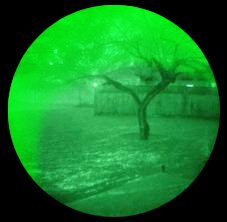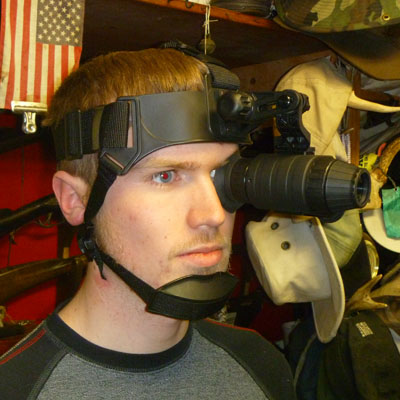Challenger G2+ 1×21 Night Vision Goggles
I recently got my hands, err, eyes on the Pulsar Challenger G2+ 1X21 Night-Vision Goggles (monocular) and I have to say, the cool factor was pretty high on this product. The Challenger G2+ 1×21 has some substantial advantages to my normal eyes: For one, it can see in the dark, and two, yes it allowed me see things that were far away, closer in the dark (about 200 meters away).
One of the nice features of this item is that it’s more than just a monocular. I used the head mounting system to give me hands-free access to things I like to do in the dark, like look for keys while not waking my wife, or watching wildlife in my backyard through its focusable optics. Side note: I now know the city I live in has a huge possum population, and those things are freaky-looking. It also doubled as a rifle scope, with a crosshair attachment that I wish I had after seeing all those possums. I also read that the Challenger G2+ NV Goggle was good for nighttime photography, but every time I took a picture of it in the darkness my photos just came up as black space. (My editor just told me that I needed to use it with the camera. My bad.) The design of the monocular is pretty sweet. Weighing in at less than a pound, it is almost completely sealed and ready to take a beating. An unintentional test was finding my 5-year-old playing with it in the dark in his room. This is the kid who can break almost anything (THIS IS WHY I CANT HAVE NICE THINGS!) and yet the product looked as good as new and functioned as if I just pulled it from the box. It is also capable of being used in almost any weather (fog, heavy shower, dusty environment, sand storm, etc.). I personally had it out in heavy snow and subzero weather with no issues at all.
The on/off switch is located in the front of the monocular, which at times can be a bit hard to find, but never impossible. It has three settings: on, on with IR illuminator, and off (yes “off” is a setting). I would suggest always using the IR illuminator as I found the image to be grainier when just running it in on-mode.
One issue I found with this product was outside light bleeding. The lens itself is curved and causes a bit of distortion on the edges, and while you use them in darkness, if a streetlight were to catch the edge of the beveled lens the light spreads across your viewing field. A full moon tended to have this effect as well.
I wear glasses, and the headgear allowed me to keep them on, and the eye relief was large enough to help me maintain a comfortable view without the need to take the glasses off. It is also set up so you can use either eye. The headgear, while fantastic in its comfort, holding the monocular in place, and allowing you to flip up the monocular when not in use, you feel a bit odd when you put the chin strap on and the nylon webbing around your head. Finally with a $2,700-plus price tag, I would have to say that while as great in features and functions, this product is limited in its civilian applications. As it is a ranged viewfinder, you have to become accustomed to objects being farther away than they appear. Now unless you are hunting or taking photos in the dark, I would suggest you just save up your money and just buy a bunch of flashlights or wait till morning to get those elusive keys.
For more information, check Pulsar out at www.pulsar-nv.com.






You must be logged in to post a comment.